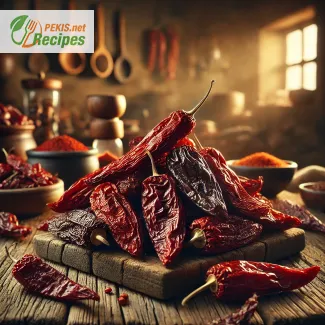
Discovering Ancho Chile: The Ultimate Guide to Its Uses, Benefits, and Recipes
What is Ancho Chile?
Ancho chile is one of the most essential dried chiles used in Mexican and Latin American cuisine. Known for its mild heat and rich, smoky flavor, this dried poblano pepper adds depth to dishes ranging from sauces to marinades and even desserts. Despite its humble appearance, ancho chile is packed with nutritional benefits, culinary versatility, and a unique ability to enhance flavors.
This guide explores everything about ancho chile, from its characteristics and substitutes to its health benefits and how it transforms food. Whether you are a home cook or a professional chef, understanding ancho chile will elevate your cooking to a whole new level.
Characteristics of Ancho Chile
Ancho chile is the dried version of the fresh poblano pepper. The drying process enhances its flavor, making it more complex with earthy, sweet, and slightly smoky notes. Here are its key characteristics:
- Color and Texture: Deep reddish-brown to black, with a wrinkled, flexible skin.
- Size and Shape: Broad, heart-shaped, and about 3 to 4 inches long.
- Flavor Profile: Mild heat with hints of raisins, chocolate, and smokiness.
- Scoville Heat Units (SHU): 1,000 to 2,000 SHU (considered mild compared to spicier peppers).
- Aroma: Sweet, slightly smoky, with notes of dried fruit and tobacco.
Best Substitutes for Ancho Chile
If you don’t have ancho chile on hand, here are some great substitutes:
- Pasilla Chile – Similar in smokiness but slightly hotter.
- Guajillo Chile – Has a more tangy and slightly more intense heat.
- Mulato Chile – Offers a deeper, chocolate-like flavor, ideal for complex dishes.
- Chipotle Chile – Provides a smokier, spicier alternative.
- Smoked Paprika – A good non-chile alternative with a smoky kick.
Each substitute slightly alters the final taste, so choosing the right one depends on the desired flavor profile of your dish.
Why Is Ancho Chile Used in Cooking?
Ancho chile is prized for its rich umami and earthy sweetness, which makes it an indispensable ingredient in many dishes. Here’s why it’s widely used:
- Enhances Sauces and Marinades: Forms the base of famous sauces like mole poblano and adobo.
- Balances Heat and Sweetness: Its mild spiciness pairs well with sweet, tangy, or smoky elements.
- Adds Depth to Soups and Stews: Used in traditional broths like pozole and birria.
- Versatile in Sweet and Savory Dishes: Can be incorporated into chocolate-based desserts, barbecue rubs, and infused oils.
The Hidden Secrets and Culinary Effects of Ancho Chile
One of the greatest secrets of ancho chile is its ability to deepen and enhance flavors without overpowering a dish. Here’s how it works:
- Brings out natural sweetness: The mild heat amplifies the natural sugars in food.
- Enhances umami flavors: Works well with meat, mushrooms, and umami-rich ingredients.
- Thickens sauces naturally: Its pulp creates a rich and velvety texture in stews and sauces.
- Balances acidity: Helps counteract the sharpness of tomatoes and vinegar-based dishes.
These effects make ancho chile a powerful ingredient that subtly transforms meals into gourmet-level creations.
Why Is Ancho Chile So Good for Recipes?
Chefs and home cooks alike love ancho chile because it is:
- Mild yet Flavorful: Enhances taste without overwhelming spiciness.
- Extremely Versatile: Works in everything from salsas to desserts.
- Great for Infusions: Can be used in oils, sauces, and spice blends.
- Perfect for Layering Flavors: Combines well with herbs, spices, and citrus elements.
Because of its mild heat, ancho chile is also an excellent gateway spice for those who are not accustomed to spicy food but still want to explore deeper flavors.
How Ancho Chile Works in Cooking
Cooking with ancho chile is all about unlocking its full potential. Here’s how to use it:
- Toasting: Dry-roast on a skillet for enhanced aroma.
- Soaking: Rehydrate in warm water for 10-15 minutes before blending.
- Grinding: Use a spice grinder to make ancho chile powder.
- Blending: Mix with tomatoes, garlic, and onions for sauces.
These steps maximize the chile’s depth and create a well-balanced flavor base for countless dishes.
Health Benefits of Ancho Chile
Ancho chile is not only flavorful but also packed with nutrients. Here are some of its health benefits:
- Rich in Vitamin A and C: Boosts immune function and skin health.
- Contains Capsaicin: Helps with metabolism and reduces inflammation.
- High in Antioxidants: Fights free radicals and promotes heart health.
- Aids Digestion: Stimulates digestive enzymes for better gut health.
Adding ancho chile to your diet is an easy way to enjoy its delicious flavors while benefiting from its nutritional value.
Growing Ancho Chile: A Complete Guide
If you want to grow ancho chile at home, consider these factors:
- Climate: Thrives in warm temperatures (65-85°F / 18-29°C).
- Soil: Requires well-draining, nutrient-rich soil.
- Watering: Needs consistent moisture but dislikes overwatering.
- Harvesting: Pick poblano peppers when green for fresh use; let them ripen and dry for anchos.
With proper care, you can grow high-quality ancho chiles in your home garden or farm.
Ancho chile is a powerhouse ingredient that brings depth, richness, and complexity to countless dishes. Its mild heat, nutritional benefits, and versatility make it a must-have in any kitchen. Whether you use it in sauces, stews, or rubs, it will elevate your culinary creations and provide a unique balance of sweetness, smokiness, and umami.
Try incorporating ancho chile into your cooking and experience the rich flavors and health benefits of this exceptional spice!